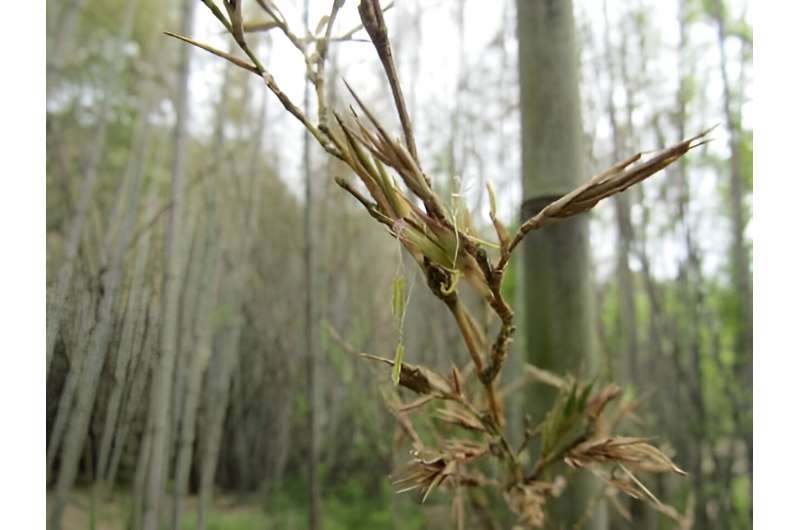This article has been reviewed according to Science X's editorial process and policies. Editors have highlighted the following attributes while ensuring the content's credibility:
fact-checked
peer-reviewed publication
trusted source
proofread
Rare bamboo flowering event could be followed by years of ecological change

Flowering for some plants is a yearly occurrence; for others, it is a once-in-a-lifetime event. A widespread species of bamboo in Japan, Phyllostachys nigra var. henonis, takes this one-time flowering event and pushes it to the extreme: they flower once every 120 years before dying to make way for the next generation.
Researchers have realized there might be another issue at hand with this monocarpic species, which is the lack of germination of the seeds from a majority of the flowering specimens. Implications of a once dense field of bamboo, something that serves both as a food source and a source of material for crafts, turning to grassland for several years until the regeneration of bamboo begins somehow, can impact the ecology of the area in addition to the country's economy.
Upon observation of some early flowering specimens, researchers decided to take advantage of this event to take a deeper look at the regeneration ecology since there is no recorded data since the last flowering of this species took place around 1908. It was found that more than 80% of the sampled culms flowered but all the flowering culms did not produce seeds, indicating this variation of P. nigra does not reliably undergo sexual regeneration via the germination of seeds.
"The bamboo did not produce any viable seeds that can germinate. Bamboo shoot production was stopped after flowering. There was no sign of regeneration of this bamboo after flowering for the initial three years," said Toshihiro Yamada, lead researcher and first author of the study now published in PLOS ONE.
About 0.17 million hectares of Japan are occupied by three species of bamboo, one of them being P. nigra var. henonis. Given that this variety of bamboo isn't producing viable seeds, it's likely once this flowering event occurs, there will be wide open areas of grasslands, changing the ecology of the area in addition to reducing the availability of bamboo as a resource.
The environmental impacts of a rapidly shifting ecological area extend past the insects and animals that rely on the food or shelter of the bamboo stand but also can impact the area for years to come considering the potential for soil erosion. Bamboo can help keep soil in place thanks to its strong and widespread rhizomes, so a sudden loss of a large area of this plant can lead to changing topography of the area.
"So a bamboo stand will turn into a grassland after bamboo flowering for at least several years. We may need to manage this drastic change after bamboo flowering," Yamada said.
There are measures that can be taken to protect the ecological habitat during the time it takes for the bamboo stands to regenerate, such as fertilizer applications or replanting the same bamboo species from non-flowering stands. However, management of the rapidly spreading rhizomatous bamboo can become an issue that would then need to be addressed regularly and somewhat aggressively.
More information to be gained includes addressing why this variety of bamboo doesn't produce many viable seeds, and from there, considerations made on the longevity of this species as a whole have to be made, too. Furthermore, due to its aggressive spread and intense management required to keep it from overtaking forests and other agricultural areas, the best time to make widespread changes might be after the flowering event when the bamboo is at its weakest.
More information: Toshihiro Yamada et al, Does monocarpic Phyllostachys nigra var. henonis regenerate after flowering in Japan? Insights from 3 years of observation after flowering, PLOS ONE (2023). DOI: 10.1371/journal.pone.0287114
Journal information: PLoS ONE
Provided by Hiroshima University



















